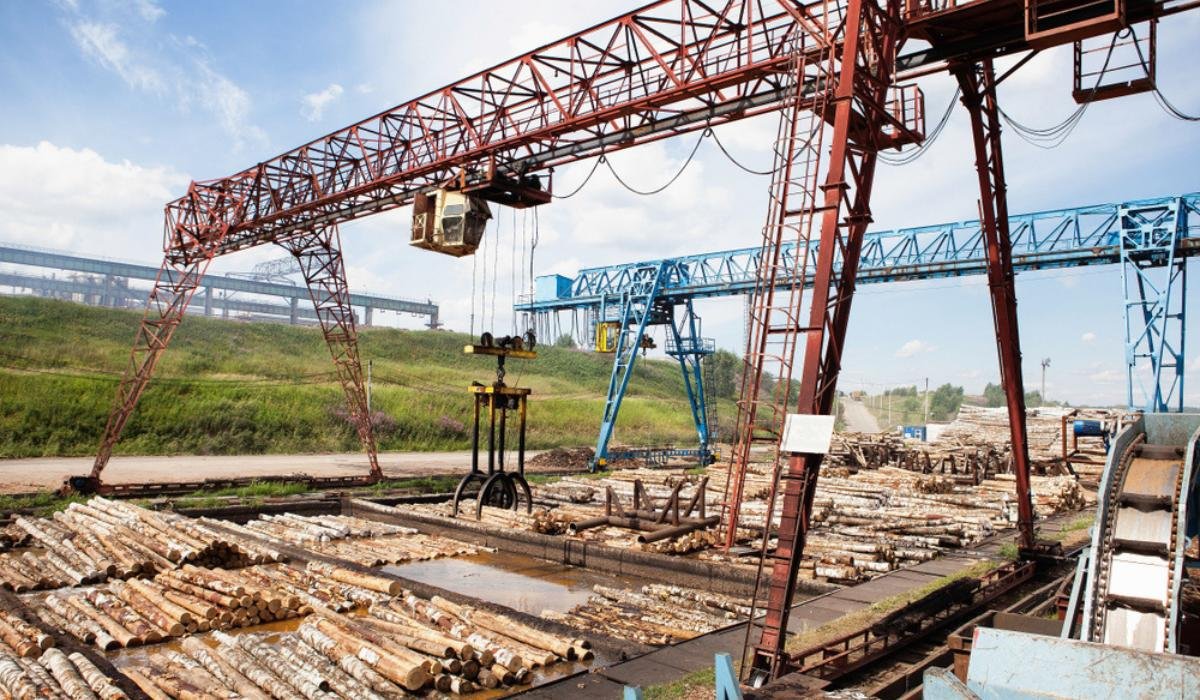Overhead moving cranes are essential in manufacturing settings for moving big loads down the length of a shed, as well as for lifting them vertically and horizontally. These cranes may be operated by either human or machine power and travel along rails attached to their extremities. A gantry girder is an overhead support structure that features rails.
In this article, we will discuss gantry girders and the various kinds of gantry girder cranes, the parameters under which they may be loaded, and the applications for which they are often used.
Gantry girder: What is it?

Source: Pinterest
Gantry girders, also known as crane girders, are used in industrial buildings like processing plants, workshops, steel production, and other similar establishments to carry overhead cranes that are either manually or electrically operated. These cranes are used to lift and transport heavy materials, equipment, and other such items from one location within the building to another.
The gantry’s primary girder supports the load that is transferred via the travel wheels in gantry girder systems. The main girder reaches from one support column to another support column. When necessary, a walkway may be constructed at the peak of the girder so that it can be examined on a regular basis.
The topmost ridge of the gantry girder serves as the attachment point for the rail, which is secured using sturdy clips. The mounting of gantry girder cranes may be done either in accordance with the slow-speed type or the high-speed type standards.
Types of gantry cranes
The following categories of gantry cranes may be found in industrial settings:
Full gantry crane systems

Source: Pinterest
This standard form of a girder includes a cross beam, limbs, and hoist, and it may move on casters, tracks, or a rail. This design is referred to as the full gantry crane. Depending on their dimensions, they may be movable or portable in nature.
Semi-Gantry crane systems

Source: Pinterest
In contrast to full-gantry cranes, which have two legs, semi-gantry cranes only need one since it is supported by an I-beam affixed to the wall. To assemble a semi-gantry crane, you will need a span, crane gearbox, trolley, and hoist. Indoors and outdoors, you’ll find semi-gantry cranes, a hybrid of traditional aerial and gantry cranes. Installing one of these underneath a working overhead crane may greatly improve productivity without affecting the crane’s movement.
Portable gantry crane systems

Source: Pinterest
Lightweight and placed on rubber tires or casters, portable gantry cranes may be moved easily. They range in height and breadth from half a to five tons of lifting capability. If you only need a lifting solution sometimes but still want the efficiency of a conventional crane, a portable gantry crane is a great option. The stuff they are lifting or placing may be transported to any area of the building.
Adjustable gantry cranes

Source: Pinterest
The adjustable cranes may be moved from one location to another or be permanently installed. Their load-carrying capacities are flexible since their height, breadth, and horizontal beam may be modified. The portability and adaptability of a crane with movable parts are two of its best features. There are both smaller, mobile gantry cranes and bigger, single-girder, fixed-position cranes available. Adjustable features and settings are common across gantry crane models.
Gantry girder: Various loading conditions
The gantry girder, which lacks lateral support throughout its length, is required to withstand the following loads:
Crane-Hauled vertical loads
The crane’s own weight, the weight of any crabs, and the crane’s own lifting capacity all add up to a vertical load that acts over the gantry girder. The maximum load on a roller is used to figure out the response. The evaluation should be proportional to the combined response of a gantry girder and the rail’s own weight.
Crane-induced impact load
The stresses that are generated in gantry girders as a result of overhead loads are much higher than the stresses that are caused by minimally provided loads. This is because of the forces that are generated as a result of the unanticipated usage of brakes in order to carry packed cranes in a smooth manner. These forces include acceleration, deceleration, vibration, and the potential slippage of slings.
For these cranes to be able to move as quickly as they do, the steelwork supporting them must be stronger. The bending strains in the gantry girders are created gradually from zero up to their peak values by slow-moving hand-operated cranes, whereas they are produced almost instantly by fast-operating Electric Overhead Travelling cranes.
Drag force
This takes place when the crane girder begins and breaks off its longitudinal transit across the crane rails. A drag force, for instance, acts in the path of the gantry girder. For either electrically or manually operated cranes, this force is equivalent to 5 percent of the stationary wheel loads.
Surge load
The following factors could persuade the existence of lateral stresses on crane girders:
Abrupt crab movement across the crane girder
The transverse gantry girders experience point loads via the main wheels transmitted from the upper or pressure flanges of the girders based on the frictional reluctance of the rail. When the gantry girder is stressed to its ultimate lateral and shear bending, the position of the massive wheels will be the same as when the moment of shear and bending are at their maximum in the vertical direction.
If the crane is moving heavy objects across the floor
When moving heavy objects over the floor, the crane is the tool of choice. If the weight is too heavy to lift, rollers are used to move it down a wooden plank track. It is thus a question of conjecture how much lateral force and drag the gantry girders will experience on their compressive flanges. The biggest impeding factor is the friction created by the many wheels rolling along the gantry rails.
Gantry girder: Uses of gantry girder cranes
Shipbuilding
The shipbuilding industry relies on gantry girder cranes for the enormous lifting required to construct ships. While construction is underway, the crane facilitates the ship’s mobility.
Warehouses
It is usually necessary to have a variety of heavy lifting equipment available for usage in warehouses. As a consequence of this, gantry cranes may be found in almost every kind of warehouse.
Automobile industry
In the field of automotive manufacturing, engines may take on a variety of forms depending on the size of the vehicles they power. The gantry girder will be of assistance throughout the whole of the lifting procedure in the automotive sector.
Manufacturing units
The manufacturing industry often uses gantry girder cranes of a smaller size for transporting elements of the product from one location to another. In manufacturing, a gantry crane with a 4-ton capacity is a standard tool in which many pallets of items may be moved simultaneously.
FAQs
Where is the usage of the gantry girder?
A gantry girder is an overhead structure used in factories to carry large materials and parts throughout the facility.
What is the distinction between plate and gantry girders?
Plate girders, which are made of steel, are the most common kind of girder, while gantry girders, which are used to support weights carried by the crane's wheels, are more specific.
What are the maximum stresses that a gantry girder may safely withstand?
In order to design a gantry girder to withstand the combined vertical and horizontal loads, it is recommended by the Indian standard IS:800 - 1984 that the permitted stresses in axial compression, axial tension, and bending, as well as the allowable stress for rivets, be raised by 10%.
Housing News Desk is the news desk of leading online real estate portal, Housing.com. Housing News Desk focuses on a variety of topics such as real estate laws, taxes, current news, property trends, home loans, rentals, décor, green homes, home improvement, etc. The main objective of the news desk, is to cover the real estate sector from the perspective of providing information that is useful to the end-user.
Facebook: https://www.facebook.com/housing.com/
Twitter: https://twitter.com/Housing
Email: [email protected]











